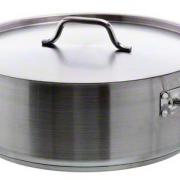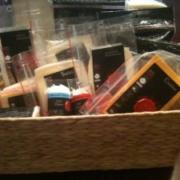What Pots Brand Should I Buy? The Skinny on Pots
What pots brand should I buy?
That is the question I am always asked at my cooking demos. Ages ago, my mother in law bought me a set of Farberware pots and pans for my shower, commenting they had served her right in all her lean years, and she hoped they would do the same for me. And serve me right they did. A few years ago, I surveyed my pots and pans “collection”, a little wistfully.
Yes, my pots and pans looked worn, and had a few bumps and a few loose screws and handles here and there, and I asked myself, “Don’t you think it is about time to get rid of them battered pots and pans and buy a spanking new line?” After all, what could be a better showcase for me?
After debating, very briefly I assure you, the question of what new pots brand to buy, I asked myself again, why? Yes, why should I get rid of them? Everyone, feel free to buy $250.00 pots, but my cheap kitchenware line and I have always been a team. I owe it much of my good cook reputation, so it has my complete allegiance. In fact I was pleased to see, at a few prestigious houseware stores, a vamped up Farberware line, somewhat sexier looking than mine, but still very economical, and highly serviceable and efficient, sturdy 18/10 stainless steel.
Please scroll down for gauge and shape pot you should shop for.
Just to encourage you not to discard your good old pots so fast, no matter how modest the pots brand: Last year I was visiting my friend Shuli in Florida, and as usual, I found her slew of cats, which she likes to call by their idiosyncratic Hebrew names: Feivish, Chaimel, Esti, etc… This time I noticed a new one, and she told me his story. She found him at the ASPCA, who was about to put him out of his misery because he was quite old and ailing. She begged them to do no such thing and to let her take him home. She said he did so well in his new setting she actually had to have him neutered. What do you know, he had a lot of life left in him!
So: no such thing as an old pot! It works, why discard it? I just won about a thousand dollars worth of magnificent All-Clad pots for a demo I gave in Bloomingdales. Please don’t get me wrong: I love that pots brand. As soon as I took them out of their wrappings, they looked so insolently beautiful that I put them away safely and completely, where my old pots, my babies, who were getting so upstaged, couldn’t take a look at them, and more importantly, couldn’t be looked at: how could I do them such an affront?
Besides, as my husband, the quintessential self employed worker, always says, “The service is you”. Yes, you, not the pot. Thirty years and much delicious food later, my opinion hasn’t changed, au contraire! I hope you are not disappointed to hear such plebeian comments from a food professional. In fact, I even hope you will be emboldened to use your ordinary tools, and a perfectly good serviceable pots brand to make wonderful food without waiting until you can afford the designer line.
Now that we had this little talk, what pots and pans should you buy?
I won’t say a word about what pots brand to pick, simply because I never want you to think that in order for you to be a good cook, you need to invest in some extravagantly priced cookware. What I do want to recommend for your pots, though, are the following pointers:
– Heavy gauge, called in the business 18/10.
– The layer directly in contact with the food must not be aluminum, as it is reactive and will leach into your food, resulting not only in a metallic off-taste but in real health hazards. (Which is the reason, by the way, you shouldn’t be cooking or baking in disposable aluminum pans. Only warming up is acceptable in disposables.) It’s OK, it’s good even, if the bottom or intermediate layer of your pot is aluminum, as it is a great heat conductor—meaning your food will cook evenly—just as long as the inside of the pot is not. We want our food to be in direct contact with stainless steel, copper, or enamel. Recently my daughter Bella replied to my question “Did you make sure you used a real cake pan?” with “Come on, Mommy. I’m your daughter. How could I use disposable?”
– A wide bottom. It makes all stove-top preparations a pleasure, as there is minimal piling and therefore allows for much better control. There’s nothing you can’t do with a broad and shallow pot: Instead of the impractical 9-inch round, 12-inch- high stock pot, get a 12- or even 14-inch, 6-inch-high pot. Same goes for skillet: Nice and broad please! This cute Aesop fable will make my point in full: The fox invited the stork to his house and served her food in a wide shallow bowl; and of course she couldn’t get to it, so the foxy fox polished off her meal as well, just as he had planned all along. When she invited him, she served him in a long narrow bowl, and feasted on her food . . . and his. You have guessed it: We are the foxes!











